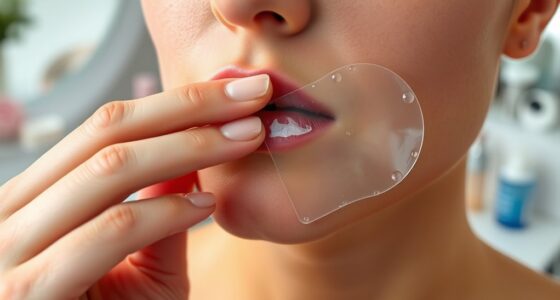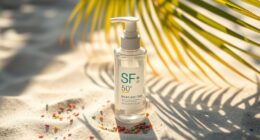Pimple patches aren't effective for treating cystic acne, which occurs deeper beneath the skin. These patches mainly target surface-level blemishes and can't penetrate deep enough to address underlying issues. You might find temporary relief, but true treatment requires a thorough skincare routine, possibly with oral medications or professional advice. Understanding the limitations of pimple patches can guide you toward better solutions for managing cystic acne, along with tips for enhancing your overall skincare routine.
Key Takeaways
- Pimple patches primarily target surface-level blemishes and are ineffective for deep cystic acne inflammation.
- Hydrocolloid technology in patches does not penetrate deeply enough to address underlying issues of cystic acne.
- Active ingredients like salicylic acid in patches may not provide sufficient relief for deep cystic breakouts.
- Relying solely on pimple patches neglects the importance of a comprehensive skincare routine for managing cystic acne.
- Consulting a dermatologist is essential for personalized treatment plans that effectively target cystic acne beyond temporary patch solutions.
Understanding Cystic Acne and Its Challenges

Cystic acne can be particularly challenging to deal with because it forms deep beneath the skin, often causing painful and inflamed cysts. Understanding cystic acne is essential for effective management.
This severe form of acne results from hormonal fluctuations, excess oil production, and bacterial infection. Topical solutions alone typically aren't enough to combat the inflammation rooted deeper in your skin. A thorough skincare routine, combined with oral medications, can be more effective in reducing inflammation and preventing scarring and hyperpigmentation.
The visible and painful nature of cystic acne often leads to emotional distress, impacting your self-esteem. Addressing these challenges requires a dedicated approach, balancing both skincare and emotional well-being for the best results. Additionally, incorporating essential oils for inflammation can provide supportive relief in managing the discomfort associated with cystic acne.
The Role of Pimple Patches in Acne Treatment

Managing cystic acne often requires a multi-faceted approach, leading many to explore various treatment options, including pimple patches.
While these patches contain hydrocolloid technology that absorbs excess fluid and helps in reducing inflammation, they're primarily designed for surface-level blemishes.
Pimple patches utilize hydrocolloid technology to absorb fluid and reduce inflammation, but they target primarily surface-level blemishes.
You might find that the active ingredients, like salicylic acid and tea tree oil, aren't present in sufficient quantities to effectively treat cystic acne.
Though pimple patches can offer temporary relief and protection, they're not a substitute for an extensive acne treatment plan.
Many users report limited effectiveness on stubborn cystic acne, showing that while pimple patches can be part of your routine, they shouldn't be relied upon solely for long-term management. Additionally, hydrocolloid patches are recommended by dermatologists for localized treatment in various skin types, which can complement other acne therapies.
Limitations of Pimple Patches for Cystic Acne

While pimple patches can be helpful for surface-level acne, they often fall short when it comes to cystic acne.
The ingredients in these patches mightn't be strong enough to tackle deeper inflammation, leaving you wanting more effective solutions.
Relying solely on them could prevent you from addressing the root causes of your cystic acne. Additionally, the hydrocolloid technology used in some patches may not penetrate deeply enough to effectively target cystic lesions.
Surface-Level Treatment Only
Though pimple patches offer a convenient solution for minor blemishes, they fall short when it comes to treating cystic acne. These patches primarily target surface-level issues, using hydrocolloid material to absorb excess fluid.
Unfortunately, they can't address the underlying causes of cystic acne, like oil overproduction and clogged pores. While ingredients like salicylic acid may be included, their concentrations are often insufficient for effectively treating the deeper inflammation associated with cystic acne.
Relying solely on pimple patches can lead you to neglect a thorough skincare routine that tackles root causes. Instead of temporary relief, it's essential to adopt a more holistic approach to your skincare to properly manage cystic acne. Additionally, incorporating anti-inflammatory properties can further enhance your skincare regimen and improve overall skin health.
Ingredient Effectiveness Variability
Many people find that the effectiveness of pimple patches can vary considerably, especially when it comes to treating cystic acne.
These patches often contain ingredients like hydrocolloid and salicylic acid, but their concentrations mightn't be strong enough for deeper inflammation. While hydrocolloid helps absorb surface fluid, it doesn't tackle the underlying issues like clogged pores and excess oil.
Additionally, the active ingredients need extended contact time to work properly, yet many users don't leave them on long enough. Since pimple patches are mainly designed for surface-level blemishes, individuals with cystic acne may find them less effective compared to others.
Your skin type can further influence ingredient effectiveness, adding to the variability in results. Moreover, it's important to consider essential oil safety when exploring additional treatments, as some oils may irritate sensitive skin or cause adverse reactions.
Key Ingredients in Pimple Patches: What to Know

What should you know about the key ingredients in pimple patches? These patches often contain hydrocolloid, which helps absorb excess fluid and reduce inflammation, making them ideal for surface-level acne but less effective for cystic acne. Common active ingredients like salicylic acid and tea tree oil promote exfoliation and have antibacterial properties, though their concentrations may not be strong enough for deeper cystic issues. Some patches utilize microneedling technology to deliver active ingredients deeper, but results can vary. Here's a quick overview:
| Ingredient | Function | Effectiveness for Cystic Acne |
|---|---|---|
| Hydrocolloid | Absorbs excess fluid | Low |
| Salicylic Acid | Exfoliation | Moderate |
| Tea Tree Oil | Antibacterial | Low |
It's important to note that maintaining skin hydration can also play a crucial role in supporting overall skin health while using these patches.
Alternative Treatments for Cystic Acne

When dealing with cystic acne, it's vital to explore treatments beyond topical solutions like pimple patches.
While hydrocolloid patches can help with surface issues, addressing the underlying causes of acne is significant. Systemic treatments, such as oral antibiotics or hormonal therapies, work effectively to target deeper inflammation.
Additionally, consider topical options like retinoids or chemical peels with salicylic acid, which can help unclog pores and reduce outbreaks.
Laser therapy, including blue light treatments, effectively reduces bacteria on the skin, providing another avenue for severe cases. Furthermore, the popularity of natural beauty products has led many consumers to seek out gentle, non-toxic treatments that may complement traditional therapies for better skin health.
Recommendations for Effective Acne Management

To effectively manage cystic acne, you need a thorough skincare routine that includes cleansing, toning, and moisturizing. It's also essential to seek professional dermatological advice for tailored treatment options. Additionally, maintaining skin hydration is crucial for promoting overall skin health and resilience against breakouts.
Comprehensive Skincare Routine
While pimple patches can provide quick relief for individual blemishes, an all-encompassing skincare routine is essential for effective acne management.
A thorough solution includes cleansing, toning, and moisturizing to target the root causes of acne. Incorporating active ingredients like salicylic acid or benzoyl peroxide in your daily regimen can help acne by unclogging pores and reducing breakouts more effectively than hydrocolloid patches alone.
Regular exfoliation also prevents the buildup of dead skin cells that lead to acne formation. Remember, consistency in your skincare routine is vital, allowing these active ingredients to work over time. Data-driven decision-making can also be beneficial when selecting products that suit your skin type and concerns.
If you struggle with persistent or severe acne, consider consulting a dermatologist for personalized treatment plans to enhance your skincare efforts.
Professional Dermatological Advice
Seeking professional dermatological advice can greatly enhance your acne management strategy. A dermatologist can provide effective treatments tailored to your needs, especially for stubborn cystic acne.
Here's why you should consider their guidance:
- Personalized treatment plans that suit your unique skin type
- Access to thorough approaches addressing underlying issues
- Insights on integrating pimple patches into your skincare routine
- Long-term solutions that go beyond temporary relief
Relying solely on pimple patches won't tackle the deeper concerns of cystic acne. Additionally, understanding the importance of emotional and psychological support can play a significant role in managing the stress associated with acne.
Professional advice can help you understand which treatments, like topical retinoids or oral medications, might work best for you. Regular consultations guarantee you stay on track with your skincare goals and effectively manage your acne.
Targeted Treatment Options
Understanding the limitations of pimple patches for cystic acne opens the door to more effective targeted treatment options. While hydrocolloid patches can absorb excess fluid, they often lack sufficient salicylic acid to tackle the deeper inflammation of cystic acne.
Instead of relying solely on pimple patches, consider integrating a thorough skincare routine, which includes cleansing, toning, and moisturizing. These foundational practices are essential for managing your skin effectively.
For persistent cystic acne, topical prescription treatments or oral medications may offer better results. Remember, pimple patches can serve as a supplementary treatment but shouldn't replace broader strategies for long-term skin health.
Focus on targeted treatment options that address the root causes of your cystic acne for lasting improvement.
Frequently Asked Questions
Do Pimple Patches Work on a Cystic Pimple?
Pimple patches aren't very effective on cystic pimples. They mainly target surface-level acne and might provide temporary relief by reducing inflammation.
However, since cystic acne is deeper and more complex, these patches won't address the underlying issues like clogged pores or excess oil.
If you've got cystic acne, it's better to use an all-encompassing skincare routine that includes other treatments aimed at tackling those deeper-rooted problems instead of relying solely on patches.
Can a Pimple Patch Help Drain a Cyst?
Imagine a tiny sponge trying to soak up a vast ocean; that's what a pimple patch does against a cyst.
While it might seem like a good idea to use one for draining a cyst, it won't reach the depths where the real trouble lies.
You'll likely find that the patch offers only minor surface relief, leaving the deeper issues lurking beneath.
For true healing, you'll need a more powerful approach.
How Do You Flatten a Cystic Pimple?
To flatten a cystic pimple, start by applying a cold compress for 10-15 minutes to reduce swelling and pain.
Incorporate salicylic acid or benzoyl peroxide into your routine to exfoliate your skin and unclog pores.
You might also try topical treatments with retinoids to promote cell turnover.
If the cyst persists, don't hesitate to consult a dermatologist for prescription options or professional treatments that can effectively address your concerns.
What Patch Is Best for Cystic Acne?
Did you know that 80% of people experience acne at some point in their lives?
When it comes to finding the best patch for cystic acne, consider ultra invisible cystic acne patches. They're designed specifically for deep blemishes and utilize hydrocolloid technology to absorb pus and protect the area.
Users have noticed significant inflammation reduction within 48 hours, making these patches a discreet and effective solution for adult hormonal acne and sensitive skin.
Conclusion
In the battle against cystic acne, pimple patches might seem like a quick fix, but can they truly deliver? While they offer some benefits for surface-level blemishes, their limitations become glaringly obvious when faced with deeper cystic issues. As you consider your options, remember: the right treatment could be just around the corner. So, are you ready to explore alternative solutions that might finally bring you the relief you've been searching for? The answer could change everything.










